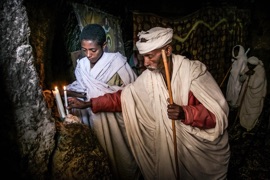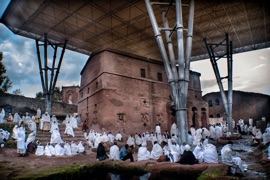Si avverte un gran silenzio dentro di noi davanti a questa raccolta di fotografie rispecchianti in pieno l’attinenza al titolo. Misticismo: l’esperienza che impegna la vita interiore dell’uomo di fronte a una realtà misteriosa, senso di religiosità profonda per cui si aspira a una vita totalmente spirituale. Ecco, questo si vede rappresentato nell’opera dell’esperta reportagista forte conoscitrice, per sapersi compenetrare, di comportamenti specifici delle Genti che vivono alle latitudini da lei visitate. Silenzio e riflessione ispirano le foto facenti parte della silloge fatta di colori sereni, ferme posture di persone oranti, bagliori e ombre dei luoghi teatri delle riprese, lampi di folgorazione mistica sui volti intenti a letture, canti, interiorità private. Saper osservare prima dello scatto deve essere la dote del fotografo che ha in animo di rappresentare la massima interiorità dell’uomo, la sua preghiera e il suo trasalimento spirituale, l’Autrice ha dimostrato questa capacità per la rappresentazione essenziale con cui ha svolto la narrazione di quest’opera, ha dimostrato conoscenza delle situazioni cui sarebbe andata incontro e, quindi, l’adeguata preparazione ha fatto sì che il lavoro non potesse avere sbavature o inesattezze. Molti sono i simboli che figurano e ben collocati nella successione della sequenza fotografica, la Croce copta, detta pure Croce ansata, ricorre più volte nella sua sembianza di chiave, segno molto importante per quel Popolo che definisce quel simbolo: Chiave del Nilo, ma ancor più importante, Chiave della vita.
L’opera si apre con la visione di una chiesa ipogea, cioè scavata nella roccia, caratteristica dei templi della chiesa copta che, l’ultimo Negus, denominò Chiesa di Stato Tawahedo, il riferimento in lingua Ge’ez è “L’essere che si è fatto Uno”; è proprio in quell’interiorità della terra che gli Etiopi cercano di immedesimarsi in quell’Uno, di avvicinarsi al suo esempio ideale poggiando mani e volto a pareti non levigate o in presenza di sontuosi arazzi o pregiate rappresentazioni di ogni genere. La luce, comprensibilmente, è scarsa in quei luoghi in cui le difficoltà di ripresa sono molte, ma quel che è nato in quella lucentissima penombra poi trasportato sulla carta fotografica è di luce piena, per la giusta sistemazione delle poche cose rappresentate, o di molte alla rinfusa, in virtù di una dote di composizione fotografica operata con sapiente conoscenza dall’Autrice che ha saputo porre il tutto in un’unica omogenea luce, quella del suo progetto iniziale, l’idea centrale che l’ha spinta a questa realizzazione fotografica, progetto di buona fotografia contenente anche una grande partecipazione del “Bello fotografico”.
Carlo Ciappi










